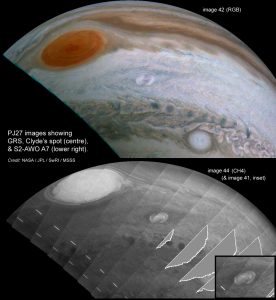The Discovery of Clyde’s Spot
2020 June, Clyde Foster
Juno images from last Tuesdays Perijove flyby (PJ27) have been downloaded from the spacecraft and are being circulated, including some preliminary results showing the outbreak that I have been credited with detecting only 2 days before the flyby (currently being referred to as “Clyde’s Spot”). Given the timing, the fact that Juno is in a 53 day highly elongated orbit, and only able to capture a thin slice of Jupiter during flyby, it is a remarkable coincidence.
The images show fascinating structures within the storm system that is already causing excitement within the Planetary Science community.
Note: An “outbreak” is a plume of gas that erupts out of and above the normal upper cloud layers of Jupiter, and is most easily detected in methane wavelengths where they show as bright. Outbreaks are common in the North and South Equatorial belts, but are rare in the South Temperate belt region where this one is, hence the interest.
I have also included my “discovery” image, where the outbreak is seen as a bright spot just to the lower right of the Great Red Spot(which is also bright at this wavelength)


